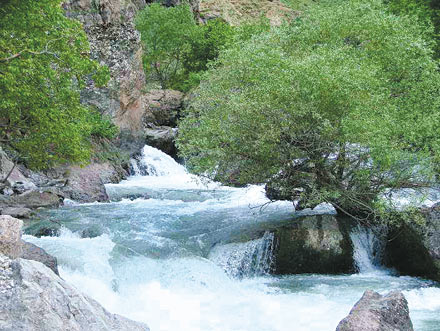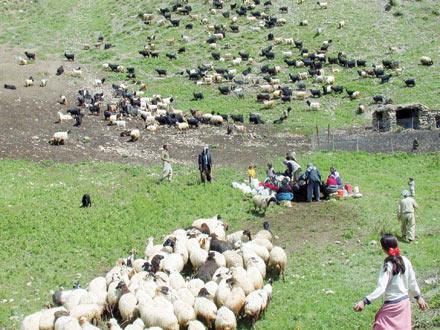

 Editor's note: "Nestorian" and "Syrian Orthodox" are the names of Assyrian church denominations.
Editor's note: "Nestorian" and "Syrian Orthodox" are the names of Assyrian church denominations.
Given its remote location amid Turkey's wildest, highest and most alpine mountain range, a whopping 1,818 kilometers southeast of İstanbul but just 75 kilometers north of the border with troubled Iraq, it's hardly surprising that few travelers venture as far as Hakkari.
The way many guidebooks write of the place is enough to put off most would-be visitors, too. "Wild Hakkari," "the positive dead-end of Turkey," "a sprawling building site of a place" and "a depressing concrete town" are just some of the dubious descriptions that must weigh heavily on even the most enthusiastic of local tourist officials. Of course there is more than a grain of truth in these assertions. Hakkari, the smallest provincial capital in the land, has expanded into a shapeless muddle of apartment blocks, largely a result of the influx of villagers forced from their ancestral mountain homes in the 1980s and 1990s by the conflict between the Turkish security forces and the Kurdistan Workers' Party (PKK).
Recent years have, however, seen the security situation -- and thus the fortunes of the town -- improve considerably. Set some 1,720 meters above sea level on a sloping alpine valley high above the mighty Zap River and facing the formidable bulk of 3,467 meter Sümbül Dağı (Hyacinth Peak), Hakkari has a natural setting splendid enough to make up for its lack of architectural grace. Its ancient citadel, set on a high hill overlooking the town, was once an Urartian fortification, and is described by the Ottoman wanderer Evliya Çelebi in his travels. Appropriately, it is still being used as a military installation, and is consequently off-limits.
 The only other building of historical importance in the town is the Meydan Medresesi, built in 1701 on the orders of the son of one of Hakkari's governors. This theological school conforms to the usual pattern for such buildings, with a double tier of acolytes' cells encircling a central courtyard. Plain and simple, it is distinguished by the particularly well-cut stone blocks used in its construction and the collection of fascinating stelae (relief carved stone markers) found in its courtyard. Dating back to between 1,450 and 1,000 B.C., each stelae depicts a bizarrely carved, naked warrior, some with swords at their sides. They are quite unlike anything else found in this part of the world and experts are still unsure who carved them and how they got here.
The only other building of historical importance in the town is the Meydan Medresesi, built in 1701 on the orders of the son of one of Hakkari's governors. This theological school conforms to the usual pattern for such buildings, with a double tier of acolytes' cells encircling a central courtyard. Plain and simple, it is distinguished by the particularly well-cut stone blocks used in its construction and the collection of fascinating stelae (relief carved stone markers) found in its courtyard. Dating back to between 1,450 and 1,000 B.C., each stelae depicts a bizarrely carved, naked warrior, some with swords at their sides. They are quite unlike anything else found in this part of the world and experts are still unsure who carved them and how they got here.
The town's current name (it was known as Julamerik or Çölemerik until quite recently) derives from Herki, the Kurdish tribe who, until a border was established between the modern states of Turkey and Iraq following the collapse of Ottoman Empire in the early 20th century, once ranged freely across the mountains between Lake Van and the Mesopotamian lowlands. Although the vast majority of the region's inhabitants are now ethnically Kurdish, this was not always the case. In the beautiful mountains some 20 kilometers north of Hakkari stands a small stone-built church that, remarkably, until 1918 was the patriarchal seat of the once powerful Nestorian Church.
Curiously, this church, known as Koçanes (or, on some maps, as Quodshanes) -- which, given its remoteness, probably ranks as the nation's least known site -- has a link with one of Turkey's most visited sites, Ephesus. In 431 B.C. the belief of Nestorius, the bishop of Constantinople, that Christ was more human in nature than divine, was declared a heresy at the Council of Ephesus. Nestorius' followers, refusing to accept the ruling, split from the mainstream Byzantine Church. Nestorianism flourished, first in Antioch (Antakya), Edessa (Urfa) and Nisbis (Nusaybin), then in Persia -- Nestorian missionaries even reached distant China and Korea and it became one of the major religions of Genghis Khan's vast Mongol Empire.
In the 14th century, though, Tamerlane persecuted the remnants of the fading creed, now largely confined to Persia, and they fled to the high mountains of southwest Iran (Zagros) and Hakkari. Bound by their faith and language (Syriac, the same language as their ethnic and Christian brethren, the Syrian Orthodox), the Nestorians developed a distinct ethnic identity in the isolated mountains of Hakkari and became a race of hardy mountaineers, split into different tribes varying little in habits and dress from the tribal Kurds long established in this remote corner of the then Ottoman Empire.
In the late 19th century a doughty British traveler, Isabella Bird, visited Koçanes when it was still a thriving -- though threatened -- Christian community presided over by the Nestorian Patriarch, Mar Shimuni. She describes it thus: "Kochanes consists of a church built on the verge of a precipice, many tombs, a grove of poplars, a slo ping lawn, scattered village houses and, nearly on the edge of a precipitous cliff, the Patriarch's residence. Everything is singularly picturesque … looking across the tremendous ravine of the Terpai [Zap] upon savage mountains, the lower slopes of which are clothed with the tawny foliage of scrub oak, the upper heights with snow."
The scene today is much as the adventurous Bird outlined. The church has survived remarkably well, its plain façade (the Nestorians were called the Methodists of the East for good reason) enlivened only by a couple of inscribed geometric decorations, its interior even more basic. The poplars are there too, as are the houses -- though they are roofless and empty following the evacuation of the Kurdish villagers at the time when the troubles with the PKK were at their height. The Nestorians who had inhabited them in Bird's day had also been forced to abandon their homes. In 1915 the Patriarch backed the invading Russians against the Nestorian's Ottoman overlords. When the Russians withdrew following the Bolshevik Revolution, fearing Ottoman reprisals, the whole Nestorian community of Hakkari packed its bags and streamed south over the mountains into what would become British-mandated Iraq.
The view east across the Zap valley from Koçanes is simply stunning, with all the peaks of Turkey's most majestic mountain range, the Cilo-Sat, filling the horizon. The view is dominated by Mt. Reşko, at 4,135 meters -- Turkey's second highest peak after Mt. Ararat. Unfortunately the range is currently off-limits, meaning visitors will have to forgo seeing Turkey's largest glacier, which issues from the foot of Reşko, the numerous other Nestorian churches dotting the highland valleys east of the Zap River and the beautiful glacial lakes that bejewel the Sat part of the range. Although the peaks bounding the western rim of the Zap are not as high as the Cilo-Sat, they are still very impressive. In spring and early summer the valleys and high pastures are carpeted with shimmering swathes of wildflower-stuffed grass, kept verdant by the maze of crystal-clear torrents dashing down from melting snow patches on the higher slopes.
The best place to absorb the beauty of these wild uplands is the yayla (summer pasture) of Berçelan, around 18 kilometers from the town of Hakkari. It is one of the best known of the literally thousands of yaylas that stud the uplands of this remote province, most of them 2,000-3,000 meters above sea level. Visit between the end of May and the beginning of September and the pasture will be home to local pastoralists and their huge flocks of sheep and goats. Life here is lived as it has been for millennia, with the yayla dwellers sleeping in black tents woven from goat hair, milking their livestock a couple of times a day, churning butter in goatskins suspended from a wooden tripod, making cheeses mixed with herbs picked from the mountainsides and baking bread in clay tandir ovens sunk into the ground. Above the yayla are the turquoise waters of a pretty, snow-rimmed glacial lake and behind it rises 3,752 meter Karadağ, a surprisingly easy day climb. Hakkari residents come to Berçelan on weekends to picnic and remind themselves of a life their families have quite likely only recently abandoned.
There's plenty more to see and do round and about Hakkari. The Zap valley itself, which you follow en route here from Van, is dramatic -- a forging green torrent of water racing headlong through a sheer-sided gorge towards Iraq. Look out for the wires stretched across the river, which locals use to haul themselves across the raging waters. Botanists will be fascinated by the presence here of the extremely rare Fritillaria imperialis (ters lale) and by the more common varieties of flower that flourish in the unique micro-climate of the Cilo-Sat Mountains -- among them African marigolds, violets and snowdrops.
Hakkari may lack the obvious attractions of more commonplace tourist destinations, but the sheer grandeur of its mountain surroundings and fascinating local culture make it one of Turkey's most worthwhile objectives.
www.todayszaman.com

or register to post a comment.